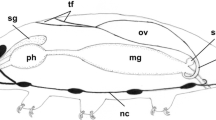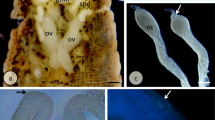Abstract
The structure of the developing oocytes in the ovary of unfed and fed femaleArgas (Persicargas) arboreus is described as seen by scanning (SEM) and transmission (TEM) electron microscopy. The unfed female ovary contains small oocytes protruding onto the surface and its epithelium consists of interstitial cells, oogonia and young oocytes. Feeding initiates oocyte growth through the previtellogenic and vitellogenic phases of development. These phases can be observed by SEM in the same ovary.
The surface of isolated, growing oocytes is covered by microvilli which closely contact the basal lamina investing the ovarian epithelium and contains a shallow, circular area with cytoplasmic projections and a deep pit, or micropyle, at the epithelium side. In more advanced oocytes the shell is deposited between microvilli and later completely covers the surface.
Transmission EM of growing oocytes in the previtellogenic phase reveals nuclear and nucleolar activity in the emission of dense granules passing into the cytoplasm and the formation of surface microvilli. The cell cytoplasm is rich in free ribosomes and polysomes and contains several dictyosomes associated with dense vesicles and mitochondria which undergo morphogenic changes as growth proceeds. Membrane-limited multivesiculate bodies, probably originating from modified mitochondria, dictyosomes and ribosomal aggregates, are also observed. Rough endoplasmic reticulum is in the form of annulate lamellae. During vitellogenesis, proteinaceous yolk bodies are formed by both endogenous and exogenous sources. The former is involved in the formation of multivesicular bodies which become primary yolk bodies, whereas the latter process involves internalization from the haemolymph through micropinocytosis in pits, vesicles and reservoirs. These fuse with the primary yolk bodies forming large yolk spheres. Glycogen and lipid inclusions are found in the cytoplasm between the yolk spheres.
Similar content being viewed by others
References
Aeschlimann, A. and Hecker, H., 1967. Observations preliminairs sur l'ultrastructure de l'ovocyte en developpement chezOrnithodorus moubata, Murray (Ixodoidea: Argasidae) Acta Trop., 24:225–243.
Aeschlimann, A. and Heckert, H., 1970, Presence de membrane annulees dans les ovocytes d'Ornithodoros moubata Murray (Ixodoidea: Argasidae) Acta Trop., 27:268–270.
Araman, S.F., 1979. Protein digestion and synthesis in ixodid females. In: J.G. Rodriguez (Editor), Recent Advances in Acarology, Vol. 1. Academic Press, London, pp. 385–395.
Balashov, Yu. S., 1972. Bloodsucking Ticks (Ixodoidea)-Vectors of Diseases of Man and Animals. Entomological Society of America, 376 pp. (English translation).
Balashov, Yu. S., 1983. An Atlas of Ixodid Tick Ultrastructure. Entomol. Soc. Am. Spec. Publ., pp. 289.
Brinton, L.P. and Oliver, J., 1971a. Gross anatomical, histological and cytological aspects of ovarian development inDermacentor andersoni Stiles (Acari-Ixodidae). J. Parasitol., 57:708–719.
Brinton, L.P. and Oliver, J., 1971b. Fine structure of oogonia and oocyte development inDermacentor andersoni Stiles (Acari-Ixodidae). J. Parasitol., 57:720–747.
Burgdorfer, W. and Varma, M.G.R., 1967. Trans stadial and transovarial development of disease agents in arthropods. Annu. Rev. Entomol., 12:347–376.
Chinery, W.A., 1965. Studies of the various glands of the tickHaemaphysalis spinigera Neumann 1897. Acta Trop. 22:235–266.
Diehl, P.A., 1970. Zur Oogenese beiOrnithodoros moubata Murray (Ixodoidea: Argasidae) unter besonderer Berücksichtigung der Vitellogenese. Acta Trop., 27:301–355.
Diehl, P., Aeschlimann, A. and Obenchain, F.D., 1982. Tick reproduction: oogenesis and oviposition. In: F.D. Obenchain and R. Galun (Editors), Physiology of Ticks. Pergamon Press, Oxford, pp. 277–350.
El Shoura, S.M., 1987a. Malpighian tubule ultrastructure of the femaleArgas (Persicargas) arboreus (Ixodoidea: Argasidae) before and after feeding. J. Med. Entomol., 24:477–484.
El Shoura, S.M., 1987b. Fine structure of the Gene's organ, in the camel tickHyalomma (hyalomma) dromedarii (Ixodoidea: Ixodidae). J. Morphol., 193:91–98.
Hecker, H. and Aeschlimann, A., 1970. Ultrastrukturelle Aspekte der Eibildung beiRhipicephalus bursa (Canestrini and Fanzago) (Ixodoidea: Ixodidae). Z. Trop. Parasitol., 21:31–45.
Huebner, E., Tobe, S.S. and Davey, K.G., 1975. Structural and functional dynamics of oogenesis inGlossina austeni vitellogenesis with special reference to the follicular epithelium. Tissue Cell, 7:535–558.
Jaskoski, B.J. and Butler, V.L., 1971.Rhipicephalus sanguineus: amino acid composition of eggshell. Exp. Parasitol., 30:400–406.
Jenni, L., 1971. Sunthese und Aufnahme von Proteinen während der Vitellogenese in Ovocyten vonOrnithodoros moubata Murray (Ixodoidea: Argasidae). Acta Trop., 28:105–163.
Khalil, G.M., 1969. Biochemical and physiological studies of certain ticks (Ixodoidea). Gonad development and gametogenesis inArgas (Persicargas) arboreus Kaiser, Hoogstraal and Kohls (Argasidae). J. Parasitol. 55:1278–1297.
Khalil, G.M., 1970. Biochemical and physiological studies of certain ticks (Ixodoidea). Gonad development and gametogenesis inHyalomma (H.) anatolicum excavatum Koch (Ixodidae). J. Parasitol. 56:596–610.
Lees, A.D. and Beament, J.W.L., 1948. An egg-waxing organ in ticks. Q. J. Microsc. Sci., 89:291–332.
Raikhel, A., 1978. Ultrastructural aspects of oogenesis in the ixodid tickHyalomma asiaticum. Tr. Zool. Inst. Akad. Nauka SSSR, 77:37–46.
Roshdy, M.A., 1967. Histochemical studies on the developing oocytes of the tick,Argas persicus Oken. Proc. Zool. Soc. U.A.R., 2:11–26.
Rubenstein, E.C., 1979. The role of an epithelial occlusion zone in the termination of vitellogenesis inHyalophora cecropia ovarian follicles. Dev. Biol. 71:115–127.
Telfer, W.H., Huebner, E. and Smith, D.S., 1984. The cell biology of vitellogeneic follicles inHyalophora and Rhodnius. In: R.C. King and H. Akai (Editors), Insect Ultrastructure, Vol. 1. Plenum Press, New York, pp. 118–146.
Wagner-Jevseenko, O., 1958. Fortpflanzung beiOrnithodorus moubata und genitale Ubertragung vonBorrelia duttoni. Acta Trop., 15:118–168.
Author information
Authors and Affiliations
Rights and permissions
About this article
Cite this article
El Shoura, S.M., Banaja, A.A. & Roshdy, M.A. Fine structure of the developing oocytes in adultArgas (Persicargas) arboreus (Ixodoidea: Argasidae). Exp Appl Acarol 6, 143–156 (1989). https://doi.org/10.1007/BF01201644
Accepted:
Issue Date:
DOI: https://doi.org/10.1007/BF01201644




